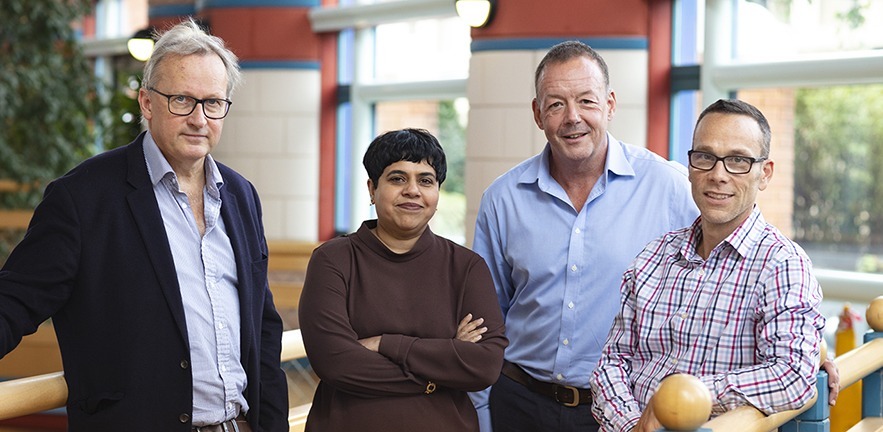Just what is “innovation” – and is there a dark side to this wave of change that has transformed our lives through technology and other breakthroughs?

In this episode, joining podcast host Michael Kitson, University Senior Lecturer in International Macroeconomics at Cambridge Judge Business School, are Cambridge Judge faculty Sucheta Nadkarni, Sinyi Professor of Chinese Management; Simon Stockley, Senior Faculty in Management Practice; and Jeremy Hutchison-Krupat, University Senior Lecturer in Operations and Technology Management.
This is the eighth in a series of “Cambridge Judge Business Debate” podcasts featuring faculty and others associated with Cambridge Judge Business School and the broader Cambridge community.
This latest podcast focuses on innovation – including the definition of the term, the role of platforms and connectivity, and the role of government in providing the right practical and legal framework.
Here is an edited transcript of some of the podcast discussion:
Innovation is one of those buzzwords that dominates corporate and economic discussion. So what is it?
Michael Kitson: “We’re continually hearing the mantra that firms have to be more innovative to thrive and prosper. But what is innovation: is it all about technological change or something broader?”
Jeremy Hutchison-Krupat: “Innovation is something, first, that is new, but it needs to be more than that: it has to be something useful, something that adds value, and the last part, something that people generally tend to forget about it, it has to be implemented.”
Simon Stockley: “One of the best definitions I’ve come across is that it’s the product of invention and commercialisation. If one of those doesn’t exist the result is zero.”
Sucheta Nadkarni: “There are different ways to look at innovation, but one of the challenges that has changed significantly is this either-or debate: incremental versus radical innovation. The challenge is for companies to do both simultaneously – that’s the idea of ambidexterity.”
What is the role of tech platforms and other types of connectivity in innovation?
Michael Kitson: “We increasingly now say that firms have to be much more open rather than closed, and it’s not just the organisation – it’s connectivity to the supply chain, their customers,to other organisations, to universities.”
Jeremy Hutchison-Krupat:“The MP3 player is a good example. The iPod wasn’t the first MP3 player – but Apple was the first with MP3 and the iPod and the whole system. With a lot of these really successful innovations we tend to forget all the other innovations that didn’t work quite so well, so we need to look at the path that led to that big breakthrough.”
Sucheta Nadkarni: “Some companies introduce everything themselves, while others have lots of different alliances.Traditionally, innovation was seen as an R&D (research and development)-driven activity – all these super-scientists driving innovation through R&D – but now you’re seeing alliances driving this.”
Innovation isn’t just about companies
Michael Kitson: “We’ve talked a lot about innovation systems at the level of the firm or the organisation, but what about innovation at the level of the city or the region or the county. How do you build a local or, perhaps more importantly, a national ecosystem of innovation?”
Simon Stockley: “One of the best case studies is here in Cambridge, where there is some really remarkable practice. If you look at the development of so-called Silicon Fen, many of those businesses were started by a relative handful of serial entrepreneurs and innovators, all of whom know each other. So they are sort of meta-connectors within the ecosystem.”
Michael Kitson: “You also have two universities (Cambridge and Anglia Ruskin) and a world-class hospital (Addenbrooke’s) here that serve as important anchors.”
Sucheta Nadkarni: “The government plays a role as well, to create an infrastructure to allow these institutions to thrive. Institutions can attract, but in order for companies to sustain it you need the basic infrastructure to allow the companies to do business.”
Jeremy Hutchison-Krupat: “It’s not by mistake that Silicon Valley is upset by how difficult it is to get visas in the US. People with the talent and ability have to be able to get there. So government is very important.”
Innovation is often seen as changing our lives for the better, but are a few companies getting too powerful?
Simon Stockley: “We had a fascinating debate in an MBA class about how society is becoming more and more polarised, perhaps through social media and these big online platforms, with views on the left and right hardening considerably.”
Michael Kitson: “That’s a worrying dimension of the concentration of power, arguably, in some platform technologies. If you take the big tech companies, you’ve got the dominance of the big five – Google, Apple, Amazon, Microsoft and Facebook – they’re innovative firms but are they good for consumer welfare? We see lots of new firms developing, but they consolidate, and then we end up in a very monopolistic situation.”
Sucheta Nadkarni: “There is the emergence of new companies, not just these five, including Alibaba and Huawei in China. So innovation gives way to new companies emerging as well, including from Asia, and they can bring very different perspectives.”
Simon Stockley: “There’s one thing we can be sure of: that at some point in the future what happened to Nokia will happen to Google, will happen to Apple, it’s just that we just don’t know when. If I were a betting man I’d bet that that threat to them will happen from China, because the rate of innovation in Chinese companies right now is quite remarkable.”


